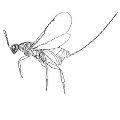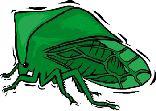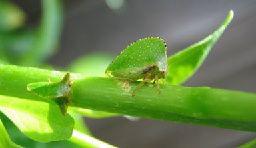Natural Solutions to Things That Bug You (37 page)
Read Natural Solutions to Things That Bug You Online
Authors: Myles Bader

MAKING TREE PASTE
This is only practical if you have a few trees that are bothered by aphids.
Make a paste of:
1/3 Sticky clay
1/3 Cow manure
1/3 Sand
Mix with water into a paste and paint it on the tree trunk and large branches.
NEVER USE ANY OILS IF THE OUTSIDE TEMPERATURE IS OVER 90
0
F
ALMOND TREES
ALMOND TREE PEST PROBLEM SOLVER
THE PROBLEM CAUSED BY
Nut meat with worms, webbing with
brownish fecal matter Navel orangeworm
Young shoots die back to several inches
from tip in spring Peach twig borers, oriental fruit moth
Leaves tied together with webbing, young
fruit eaten Leafrollers
APRICOT TREES
APRICOT TREE PEST PROBLEM SOLVER
THE PROBLEM CAUSED BY
Young shoots die back one to several inches Peach twig borer, oriental
from tip in spring,, small worms in shoots moth
Leaves and fruit webbed together and eaten in Leafrollers, tussock moth,
spring, sunken brown scars green fruitworm
Fruit may have whitish worm inside and fall Codling moth
off tree prematurely
Foliage infested with green bugs in spring, Mealy plum aphid, earwig
leaves and twigs have honeydew on them,
Irregular holes in leaves with no webbing, holes
Tiny holes in ripening fruit, green beetle with Cucumber beetle
black spots hanging around
Fruit partially eaten Birds and squirrels
APPLE TREES
APPLE MAGGOT
General Information:
 These are yellow-white legless larvae that will bore into an apple after they hatch from an egg. The eggs: are laid by the adults in small punctures in the apple. The punctures are so small that they are hardly noticeable. The problem may not become evident until you bite into the apple and find the worm. The telltale hole will appear in the apple when the worm leaves. After they become mature the maggots leave the apple and just fall to the ground, enter a pupate stage and remain for the winter. They are common everywhere apple trees are grown. These are also known as the apple tree fly or railroad worm.
These are yellow-white legless larvae that will bore into an apple after they hatch from an egg. The eggs: are laid by the adults in small punctures in the apple. The punctures are so small that they are hardly noticeable. The problem may not become evident until you bite into the apple and find the worm. The telltale hole will appear in the apple when the worm leaves. After they become mature the maggots leave the apple and just fall to the ground, enter a pupate stage and remain for the winter. They are common everywhere apple trees are grown. These are also known as the apple tree fly or railroad worm.
GET THEM DRUNK
It is best to catch the pest when it is in the fly stage before you have a problem. Set a baited trap by mixing 1 part of molasses to 9 parts of tap water then add yeast so that it will ferment and pour the liquid into a wide-mouthed jar. After the fermentation relaxes, hang the jars in the trees.
YUK, PLASTIC FRUIT AGAIN!
This will really irritate and kill them at the same time. Hang plastic fruit from the trees and paint Tanglefoot™ or Stickem™ on the fruit. They will land and be stuck for the rest of their lives.
WORMS TO THE RESCUE
One of the best ways to eliminate maggots is to apply Nc nematodes to the topsoil around the apple trees in the late summer to early fall. This will kill all the maggots as soon as they fall to the ground.
PASS HE FAUX APPLE PLEASE
If you string some fake apples that are yellow and red in the apple trees and place Tanglefoot™ or any other sticky substance on them it will trap the females that are going to lay their eggs. This should be done in the spring or early summer for the best results. You can also purchase some traps that can hang in the trees.
APPLE RED BUG
General Information:
 These bugs are normally found in the north central and northeastern United States. The bark crevices hold the eggs until they hatch and they become mature about June. They feed on the fruit and leave small russet scars or slight dimples. If you do a delayed spraying of dormant oil it should eliminate the pests.
These bugs are normally found in the north central and northeastern United States. The bark crevices hold the eggs until they hatch and they become mature about June. They feed on the fruit and leave small russet scars or slight dimples. If you do a delayed spraying of dormant oil it should eliminate the pests.
APPLE SEED CHALCID
General Information:
 This is a tiny wasp that is found in the northeastern United States and lays their eggs in apples and other fruit. The apple will have a dimpled appearance since the larvae feed on the seeds. Check the fruit for signs of dimpling and destroy the infested fruit to get rid of the problem.
This is a tiny wasp that is found in the northeastern United States and lays their eggs in apples and other fruit. The apple will have a dimpled appearance since the larvae feed on the seeds. Check the fruit for signs of dimpling and destroy the infested fruit to get rid of the problem.
BUFFALO TREEHOPPERS
General Information:

 These bugs are triangular in shape and have a short snout and horns at each shoulder. They do their damage by puncturing the bark of the trees to lay their eggs. The young trees are more susceptible to damage than the older trees. The eggs are laid in September and October. If you have this problem, don’t plant alfalfa, legumes or clover as a cover crop.
These bugs are triangular in shape and have a short snout and horns at each shoulder. They do their damage by puncturing the bark of the trees to lay their eggs. The young trees are more susceptible to damage than the older trees. The eggs are laid in September and October. If you have this problem, don’t plant alfalfa, legumes or clover as a cover crop.
Their favorite plant is bindweed, which must be kept out of orchards. Spraying with a dormant oil spray should kill the majority of the wintering eggs.
CANKER WORM
General Information:
 These worms are yellow, green or brown and spin a silken thread from which they can descend from branches on apple trees. If you cultivate the soil under the apple tree during the first week of June, chances are you will eliminate most of these worms since this is when the larvae tend to descend and enter the ground.
These worms are yellow, green or brown and spin a silken thread from which they can descend from branches on apple trees. If you cultivate the soil under the apple tree during the first week of June, chances are you will eliminate most of these worms since this is when the larvae tend to descend and enter the ground.
The canker worm will go through 10 year cycles that, which may often peak for 2-3 years. Many of the canker worms; will be eaten by birds and other types of predators.
THE ELIMINATOR
Spraying with Bt is the recommended method of controlling these bugs. Spray in April or May for the best results.
BAND THE TREES
In the fall, try placing a plastic band that has been treated with a sticky substance such as Tanglefoot around the trunk. This will stop the wingless female moths from climbing the trunk to lay their eggs.
CODLING MOTH
General Information:
 This caterpillar will bore into the core of the apple and is one of the more significant apple bugs that do crop damage. There are a number of methods of controlling the bug naturally. When you hear someone referring to the “worm in the apple” it is usually this worm. The larvae, tunnels into the core of the apple and eats the apple from the inside out. The brown reside around the opening is their excrement and is called “frass.”
This caterpillar will bore into the core of the apple and is one of the more significant apple bugs that do crop damage. There are a number of methods of controlling the bug naturally. When you hear someone referring to the “worm in the apple” it is usually this worm. The larvae, tunnels into the core of the apple and eats the apple from the inside out. The brown reside around the opening is their excrement and is called “frass.”
